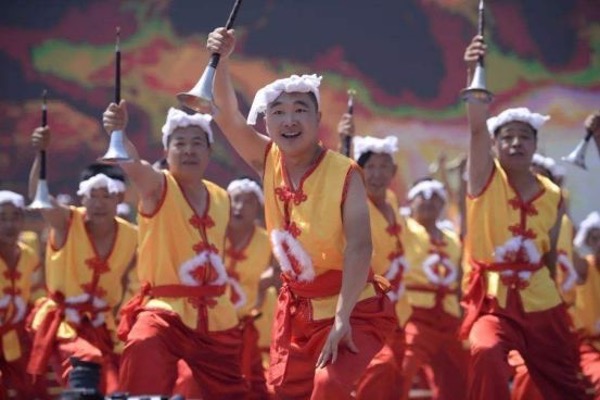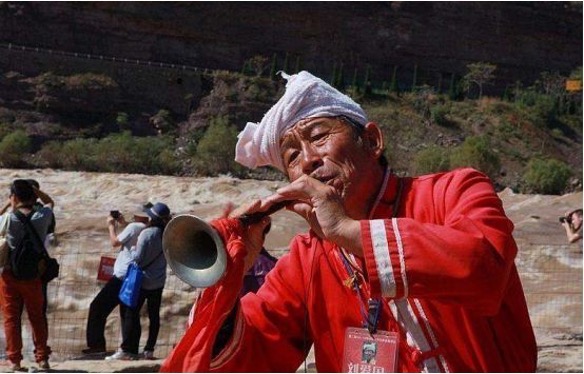Suona Horn of Ji County
- Loess Style
- Source:HUKOU
- Browse volume:
Source: Local Records of Shanxi Province
Big split pants, undergarment covering belly and chest, and leggings are the most distinctive signs of Suona horn people in Ji County, Shanxi Province on the bank of the Yellow River. Sonorous, excited, rugged and unrestrained characteristics are the specialty of suona horn performances of Ji County. Suona horn of Ji County was listed as the Intangible Cultural Heritage Expansion Project of Shanxi Province in 2009.

1. Historical Origin
Ji County has a long history of wind and percussion music. According to historical records, Shi Bao, an important official of the imperial court during the Jiajing period of the Ming Dynasty (1522-1566), angered the emperor due to the issue of imperial ritual system, and was demoted to Ji County, becoming a drummer and musician who specially worked on folk weddings and funerals, meeting the God and sacrificing. Shi Bao was originally from Gaocheng, Hebei Province and was admitted as a successful candidate in the highest imperial examination in the last year of Chenghua (1487). He was gradually promoted from the post of the highest principal of Imperial colleges in Nanjing and Beijing, and the deputy minister of the Ministry of Rites. Finally, he entered the cabinet as a minister of the official ministry and a grand secretary of Wenyuan Pavilion. After Emperor Shizongsu came to the throne, Shi Bao had a disagreement with the emperor due to the "great rite" problem in the ancestral temple. At that time, the emperor wanted him to work for emperor himself. As a result, Shi Bao not only did not support the emperor's act of arbitrarily naming his biological parents, but instead "struggling for reason, holding firmly on the theory, and hence missing the will of the emperor." Under this circumstance, the treacherous court official falsely accused him of being a treacherous party. Shi Bao was forced by the situation and had to request resignation. The former important minister Shi Bao was sent to Jizhou (now Ji County), which was far from the capital, the vast Wangjiayuan area with a sparse population on the bank of the Yellow River Hukou Waterfall. "He was demoted to be a musician and would not be subject to attend the imperial examination for the tenth century." After Shi Bao arrived in Ji County, he followed the rules of musician household. Although he was demoted to a musician household, he still inherited his family with etiquette. The whole family treats neighbors kindly, poor but not low-priced, humble but not supercilious nor obsequious. Children and grandchildren studied drum music and developed a unique skill. Whether it is the coldest days of the year or midsummer of intense heat, Shijia musician can play for several hours in one breath without moving. Shi Bao came from the court palace. He grafted some excellent elements of court music into the local popular suona tunes to make the tunes more graceful and pleasant. After years of hard work, the wind and percussion music of Ji County gradually formed its own system and passed down from generation to generation. After Shi Bao's music, the wind and percussion music of Ji County became well-known far and wide, and it played a substantial role in improving the folk music of each counties in southern Shanxi Province. Shi Bao integrated the rich court-flavored music into the Suona music, which directly influenced the later Suona horn tunes and Puju opera music. There are many jingle praising the people of Shijia musician:"when Xiguan (it is abbreviated as Shijiale because Shibao lived in Xiguan) family arrives in Xiguan, the woman will go on the sedan chair", "when Xiguan music arrives, the bridegroom smiles all over the face", "If there is no Xiguan drummer, girl won't leave anyway". Now there is also the saying that "Xiguan drummers play all over Jizhou", which means that the drummers with the surname Shi in Xiguan have been welcomed by the people of Ji County since ancient times. The counties and cities surrounding Ji County also regard suona horn of Ji County as the most authentic, and they learn competitively. The folk music of the entire southern Shanxi region is also widely influenced by the suona horn art passed down from family Shi.

2. Structure and Specialty of Suona Horn
Suona horn is more than 30cm of the whole length and consists of three parts: pole, key and bowl. The main part is called the pole, 29cm long and the inner bore is from thin to wide with the maximum inner diameter of 3cm. The wooden one is made from local materials dried from fine woods such as papaya wood, bivalve wood, black frog wood, coggygria and etc. produced in the local mountains. There are 7 holes in the front of the pole and 1 hole in the back, and each hole is carved into bamboo joints imitating bamboo. The sounding whistle is made of reed roots, and its breath-hold is a copper piece as big as a copper coin, which is stuck between the key and the pole. Both the bowl and the keys are made of copper. The copper bowl is welded by two sections. The connecting part is fixed with copper hoops. The minimum diameter is smaller than the lower end of the wooden pole so that it can be fixed to the bottom of the wooden pole with the maximum diameter of 14 cm. The whole bowl is formed in round horse-hoof shape that is completely different from the horn-shape bowls in other places. The inside of the key is rolled with extremely thin paper-like purple copper, and it is covered with two copper sleeves like candied haws on a stick , which look like a warrior helmet, which is 5cm long. The lower side gets stuck on the upper end of wooden pole and whistle can be inserted on the upper side. The most obvious difference between suona horn of Ji County and other local suona horn is its keys and bowls, which are very simple. Suona horn has 8 sound holes in the whole body, forming one octave and one more octave, and each adjacent five holes form pure five degrees, which become the unique "five-degree inter-promoting rhythm". In terms of timbre, due to the characteristics of its appearance, the timbre is also distinctively simple, dignified and unadorned,sounding uniquely. When playing, press with the index finger, middle finger, and ring finger of both hands, and press with the thumb of the left hand on the back hole. Generally, the band can be equipped with at least one piece of suona horn, two pieces, three pieces or more pieces up to one hundred pieces.

3. Repertoires of Playing
Suona horn of Ji County has many repertoires of extensive content. Representative repertoires include "The Imperial Court Going Out from the South Gate", "Confucius Returning with Weeping Face", "Walking Down for Walnuts", "Big Band", "The Son of Heaven", "Sacrifice to the Spirit", "Dressing Table", "Crying for Emperor", "Phoenix Spreading Wings Alone", "Mother-in-law Quarreling" and etc. These classic repertoires demonstrate the honest and simple nature of the local farmers, embody the magnificent emperor style, and become an indispensable audio-visual feast for the local people.

4. Skills and Inheritance of Playing
The playing skills of suona horn of Ji County are mainly taught by oral teaching that inspires true understanding inside. Superb suona horn skills, such as endless circulation of breath in the mouth and nose, blowing multiple suona horns in one mouth, playing with nostrils, simulating animal sounds, and singing like a bass, all require years of diligently learning and hard practicing to reach a certain level. "One minute on stage, ten years of work off stage" are golden and jade words bestowed by the successors of suona to generations after generations of suona horn. The inheritance of suona horn in Ji County has benefited from the inheritance from generation to generation. According to ancient records, there have been ten generations of historical inheritors. The first generation was Shi Bao (1463—year of death unknown), who performed and composed music. After the founding of New China, the Ji County suona horn people, with Yang Jisheng, Ge Wen, Liu Jinming, Zhang Xinzhong, and Feng Shuanshuan as their cores, adopted apprentices and passed on the art, cultivating many highly skilled inheritors. In recent years, the Hukou original ecological suona horn team composed of farmers in Ji County has been invited to participate in major events such as the Shanghai World Expo, Xi'an World Horticultural Exposition, and Beijing Agricultural Expo. In the sonorous and exciting suona horn sounds, people remember the roaring Hukou Waterfall and the group of bold and generous Yellow River men in Hukou, Ji County, who play with exaggerated movements and high skills.


